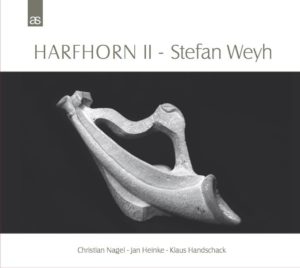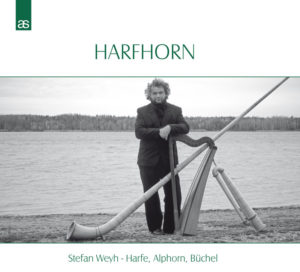Stefan Weyh – Alphorn, Büchel
Immer schon wollte ich musizieren und immer schon waren es die Blechblasinstrumente, die mich magisch anzogen. Auch das Alphorn, obwohl es ganz aus Holz ist, ist ein Blechblasinstrument, denn der Ton wird mit den Lippen blasend auf einem Kesselmundstück gebildet. Als ich mir dann als Kind eine Trompete wünschte, bekam ich ein Akkordeon! Ohne Zweifel ein schönes Instrument, welches ich auch ganz passabel spielen lernte, so wie auch später noch etliche andere, teils exotische Instrumente. Hauptsache Musik machen.
Dann lernte ich Anfang der 90er Jahre in Zella-Mehlis den Musikinstrumentenbauer Friedrich Schlütter und mit ihm das Thüringer Hirtenhorn kennen, einen Urahn aller Trompeten. Ich hatte meinen Traum von der Trompete nicht vergessen. Gleichzeitig begann ich, Posaunenunterrricht zu nehmen. Meinem Lehrer, dem Trompeter Andreas Berger, verdanke ich viel und profitiere heute noch von seinem Wissen um richtiges und effektives Lernen. Durch das Hirtenhorn angeregt, wuchs der Wunsch in mir, dessen großen Verwandten, das Alphorn kennenzulernen. Ich ahnte noch nicht, welche Rolle das Alphorn in meinem weiteren Leben spielen würde. Neben der böhmischen Harfe hat es seit langem nun tägliche Präsenz in meinem Alltag. Die Beschränkung auf die Naturtonreihe (beim Blechblasinstrument sind dies die Töne, die man ohne Zuhilfenahme von Klappen und Ventilen spielen kann), erkannte ich als Vorteil. So bin ich sicher, dass viele zu Ohrwürmern gewordene Barock-stücke ihre Entstehung den eingeschränkten Möglichkeiten der damaligen Hörner und Trompeten sowie dem genauen Wissen der Komponisten darüber verdanken.
Da ich vom Klang des Alphorns gleichermaßen überzeugt war, wie vom Klang der Harfe, begann ich mit dem Versuch, beide Instrumente simultan zu spielen. Während am Anfang des Probierens die Schwierigkeit darin bestand, alle wichtigen Abläufe zu koordinieren, zeigte sich bald ein anderes Problem als langfristige Herausforderung: Einige Töne der Naturtonreihe des Alphorns weichen von denen der temperiert gestimmten Harfe ab. Nur durch beständiges Trainieren und Hören kann man nach und nach eine Annäherung erreichen. Aber es lohnt sich.
Durch das Spielen des „Harfhorns“ habe ich viele spannende Begegnungen mit den unterschiedlichsten Menschen vor und nach Konzerten. Auch den Gastmusikern dieser Edition begegnete ich beim Musizieren. Jan Heinke z. B. hörte ich zum ersten Mal bei einem Benefizkonzert 2007. Ich war sofort von seiner Kunst beeindruckt und spielte seitdem manches Konzert mit ihm. Und so war es auch mit den anderen ….
Making music has always been my passion and it were always the brass instruments which magically attracted me. Even the alphorn, despite being made entirely from wood, is considered a brass instrument, because sound is being produced by the lips via a round mouthpiece. However, when
I wanted a trumpet as a child, I received an accordion instead! It still was a beautiful instrument, which I learned to play fairly well, just like plenty other more or less exotic instruments. All that mattered was making music.
Later, in the early 90s, I made the acquaintance of the music instrument manufacturer Friedrich Schlütter, and with him the Thuringian shepherd horn, an ancestor of all trumpets. I never stopped dreaming of the trumpet. At the same time, I started taking trombone lessons. I owe much to my teacher, the trumpeter Andreas Berger, and continue to benefit from his knowledge about proper effective learning to this day. Inspired by the shepherd horn, my wish grew to learn more about its close relative, the alphorn. I did not anticipate back then the role the alphorn was about to play in my life. By now, it has taken its place in my daily life next to the bohemian harp.
I recognized the restriction to harmonic series (which are the sounds a brass instrument can produce without utilizing keys or valves) to be an advantage. Thus I am convinced that many catchy tunes from the baroque era owe their emergence to the limited possibilities of horns and trumpets from that time, as well as composers’ precise knowledge about them.
Being equally won over by the sound of alphorn and harp, I started attempting to play both instruments simultaneously. While coordinating all the sequences made up most of my early attempts’ difficulties, I soon faced another long-term challenge: Some of the alphorn’s natural tones deviate from those of a harp with tempered tuning. A convergence can only be achieved bit after bit by constant training and listening. But it is worth the effort.
By playing the “harfhorn”, I had many exciting encounters with the most diverse kinds of people before and after concerts.
That is also how I met the musicians featured in this edition. I heard Jan Heinke, for example, for the first time during a charity concert in 2007.
I was instantly amazed by his performance and have been playing several concerts alongside him since then. The same goes for the others…


